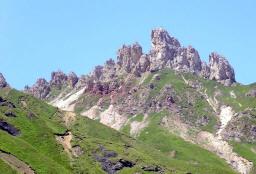Italy's spectacular Dolomite mountain range moved closer to joining the celebrated World Heritage List after advisory body earlier this month said the mountains meet two of UNESCO's established criteria for World Heritage Sites.
The International Union for the Conservation of Nature (IUCN) endorsed the nomination based on the Dolomites exceptional natural beauty and as outstanding examples of the earth's geological evolution.
IUCN said the Dolomites are widely regarded as being among the most ''attractive mountain landscapes in the world'', with spectacular vertical forms in sharp contrast to horizontal surfaces.
The organisation's report added that the diverse landscapes are famous not only for their physical characteristics, ''but also for they way respond to natural changes in light'', creating stunning views of bare rock surfaces towering over the forests and meadows below.
The rock type, the mineral, and the distinctively pale-coloured Dolomite mountain range itself are named after the 18th century French mineralogist De'odat de Dolomieu, the first to describe dolomite from this area.
Geologists have been keen to study the Dolomites ever since and their writings, drawings and photographs reveal an equal fascination for the mountains' beauty.
IUCN's verdict on the Dolomites' geomorphology points out the significance of the wide range of landforms related to erosion, tectonic shifts and glaciations.
The number of extremely varied limestone formations includes peaks, towers, pinnacles and some of the highest rock walls in the world.
Geologically, the Dolomite's preservation of fossilized reefs from the Mesozoic era and evidence from earlier and later periods are also considered of internationally value.
Finally, although not included in the UNESCO nomination, IUCN experts point out the national and regional importance of the site's biodiversity; the flora of the Dolomite region includes nearly 2,400 plants.
The Belluno Dolomite group alone has 1,350 species - a quarter of Italy's flora - and 55 forest types. As with the flora, the fauna is typical for the region but made diverse by different habitats, altitude and geographic location.
Currently the remoter areas are being gradually re-colonised by large carnivores; decreased use of valleys and alpine pastures has encouraged the return of bears and lynx, previously killed to protect livestock.
Less intervention has also allowed forests to spread up and down the slopes, a factor which may increase the area's ability to withstand climate change.
